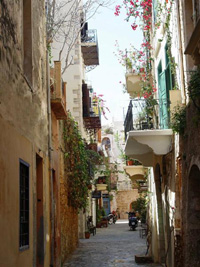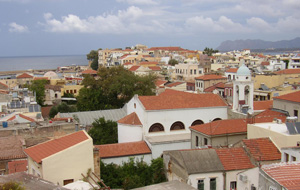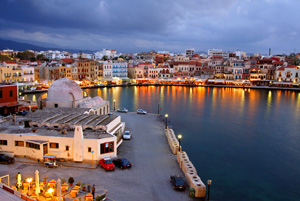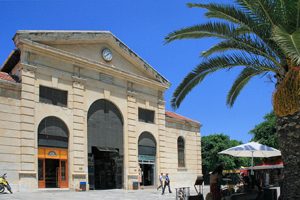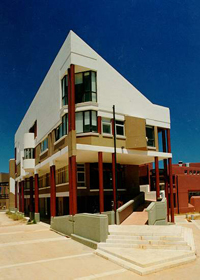Sights at Chania
The city of Chania can be divided in two parts: the old town and the modern city which is the larger one.
The old town is situated next to the old harbour and is the matrix around which the whole urban area was developed. It used to be surrounded by the old Venetian fortifications that started to be built in 1538; of them the eastern and western parts have survived.
From the south, the old town is continuous with the new, and from the north the physical border is the sea. The centre of the modern city is the area extending next to the old town and especially towards the south.
- Old town of Chania
- Modern city
- Other sights in the area
The old town of Chania
Despite being heavily bombed during World War II, Chania's Old Town is considered the most beautiful urban district on Crete, especially the crumbling Venetian harbour. The borders of the Old Town are the mostly destroyed old Venetian wall (and bulwarks) and this has been the cradle of all the civilizations which were developed in the area. The central part of the old town is named Kasteli and has been inhabited since Neolithic times.
It is located on a small hill right next to the seafront and has always been the ideal place for a settlement due to its secure position, its location next to the harbour and its proximity to the fertile valley in the south. Nowadays it is a bit more quiet than the neighbouring areas of the west part of the district.
The Splantzia quarter (next to the east part of Kasteli) is also largely untouched and very atmospheric. A plan for its future development is now under consideration.
The main square of the Old Town (next to the west end of Kasteli) is the Eleftherios Venizelos Square ("Syntrivani"). It is the heart of the touristic activities in the area.
Next to this (on the west side) lies the Topanas district, which used to be the Christian part of the city during the Turkish occupation. Its name comes from the Venetian ammunition warehouse (Top-Hane in Turkish), which was located there.
The Jewish quarter ("Evraiki" or "Ovraiki") was located at the north-west of the Old Town, behind the harbour and within the borders of Topanas. The whole Topanas area is generally very picturesque, with many narrow alleys and old charming buildings, some of which have been restored as hotels, restaurants, shops and bars. This makes it a lively and colourful place especially during the warm period (April–October).
In the winter, it still remains a center of activities (especially for nightlife) but in a more quiet and atmospheric way.
Finally, a very distinctive area of the Old Town is the harbour itself and generally the seafront ("akti"). Akti Tompazi, Akti Kountouriotou and Akti Enoseos (marina) all feature several historical buildings and a thriving nightlife.
The main street that combines the modern town with the old town is Halidon Str.
The modern city
The modern part of Chania is where most locals live and work. It is less traditional than the old town, but there are still areas of charming beauty or of some historical interest. The oldest district (early 18th century) of the modern city is Nea Hora (meaning "New Town") which is located beyond the west end of the old town. It is a developing area, but also a very picturesque one, with narrow old lanes leading to a small fishing harbour.
During the same era the district of Halepa begun to grow to the east of the city and used to be home for the local aristocracy. Some of the historical buildings of the area (including old embassies of foreign countries) had been destroyed or abandoned during the later decades of the 20th century, and it was only recently when some interest was shown for the restoration of the remaining ones.
Other historical buildings in the area include Eleftherios Venizelos’s House (built 1876-1880), the old French school (now property of the Technical University of Crete, housing the Department of Architecture), the Church of Agia Magdalini (built 1901-1903), The “Palace” (built 1882, house of Prince George during the period of the Cretan independence) and The Church of Evangelistria (built 1908–1923).
Part of the marine area of Halepa is called Tabakaria, where a unique architectural complex of old leather processing houses is situated. The district of Koum Kapi (the Venetians had first named it "Sabbionara", which means "the Gate of the Sand", the same as "Koum Kapi") situated beyond the walls at the eastern part of the old town, was also one of the first places to be inhabited outside the fortification walls.
Initially, it was home for the "Halikoutes", a group of Bedouins from North Africa who had actually settled there since the last years of the Turkish occupation. Nowadays it is a developing area with many trendy cafes, bars and restaurants on its picturesque beach.
Apart from the previously mentioned older districts of the modern part of the town, several new residential areas have been developed during the 20th century, like Agios Ioannis, Koumbes, Lentariana etc. Some part—but not the biggest—of the city centre is dominated by colourless medium-height block buildings, typical of the urbanization period of Greece (1950–1970).
However, there are still some beautiful neoclassical houses especially at the eastern part of Chania and some of the neighbourhoods surrounding the centre are quite picturesque. The plan of the central area is very good, there are some nice parks and several sports grounds, the most important being the Venizeleio Stadium of Chania and the Swimming Pool at Nea Hora. The 1913 indoor market ("Agora"), a large building based on the market of Marseille, is on the edge of the old town and is popular with tourists and locals alike.
Some other important sites of the newer urban area are The Court House ("Dikastiria", built late 19th century), The Public Gardens ("Kipos", created 1870), The Garden Clock-Tower ("Roloi", built 1924–1927), The Episcopal Residence (Bishop's residence, "Despotiko", built early 19th century) and the House of Manousos Koundouros (built 1909), the Cultural Centre ("Pnevmatiko Kentro"). The central largest squares in Chania are the Market Square ("Agora"), the Court House Square ("Dikastiria") and the "1866 Square".
In the last two decades there has been a profound movement of Chania residents towards the suburbs, as well as towards areas around the city which used to be rural, mainly the Akrotiri Peninsula.
Other interesting sights in the area
- Old town and venetian port
- Mosque of Küçük Hasan
- Nautical Museum of Crete (Old Town)
- Archeological Museum of Chania (St. Francesco)
- Byzantine/Post-Byzantine Collection
- House of E. Venizelos
- War Museum
- Folklore Museum
- Historical Archive (the second most important in Greece)
- Centre for Cretan Law
- School Life Museum
- Museum of Typography
- Municipal Gallery
- Museum of Chemistry
- Center of Mediterranean architecture
- Philological Association "Chrysostomos"
- Ancient Aptera in Apokoronas



